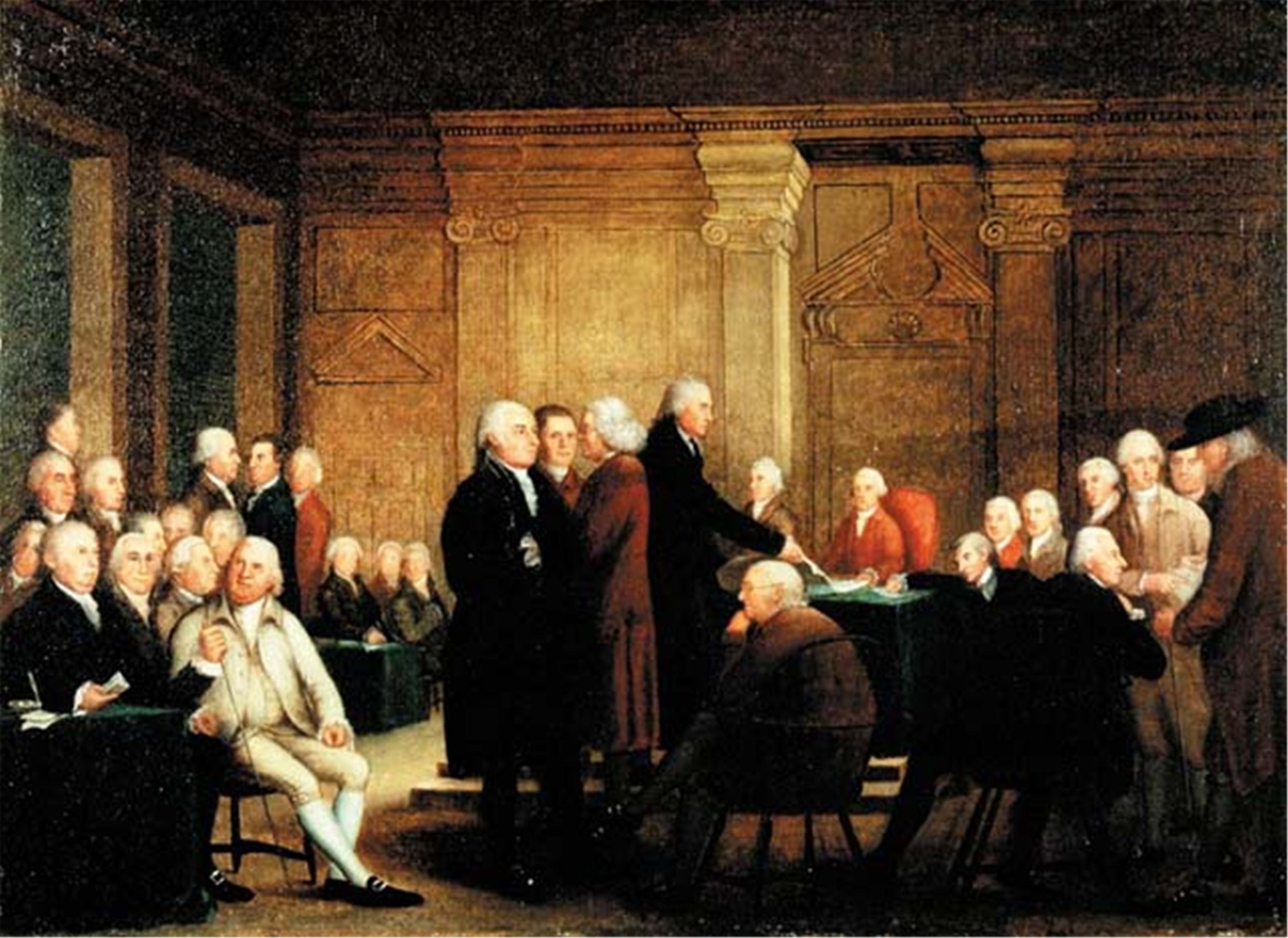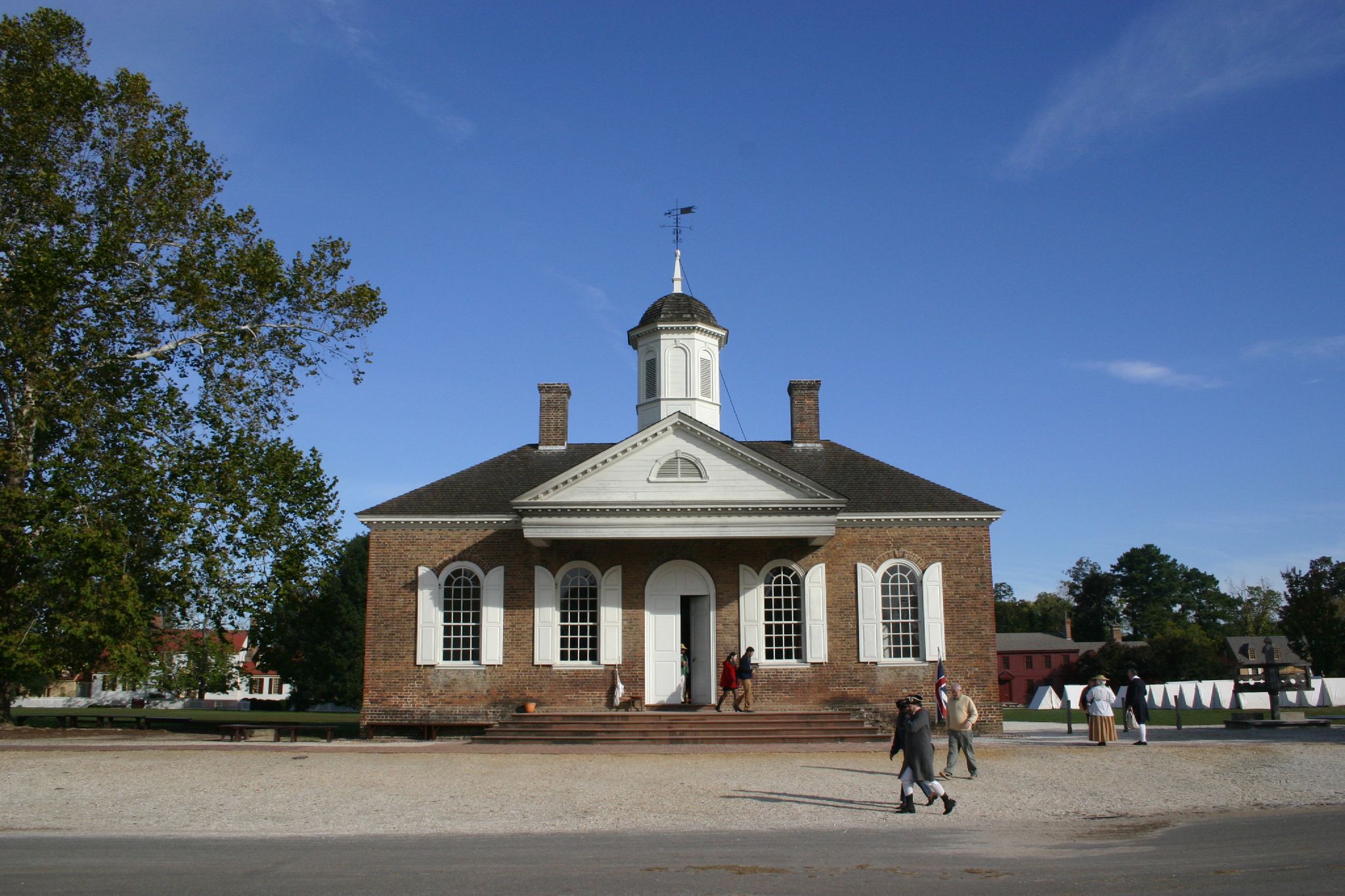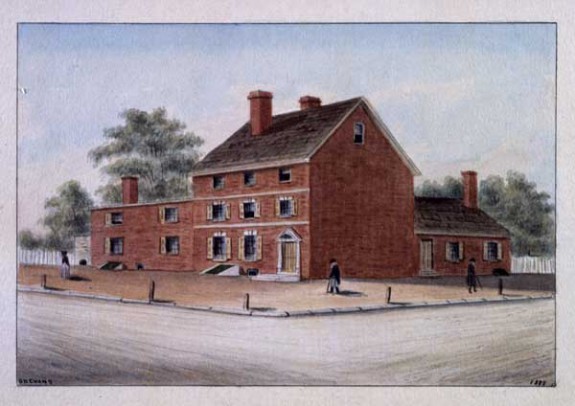|
Board Of War And Ordnance
The Board of War, also known as the Board of War and Ordinance, was created by the Second Continental Congress as a special standing committee to oversee the American Continental Army's administration and to make recommendations regarding the army to Congress. On January 24, 1776, Congressional delegate Edward Rutledge, echoing General George Washington's own concerns, suggested that a war office similar to Great Britain's be established. Pressure from Washington and the large volume of military business led Congress to establish the Board of War and Ordnance on June 12, 1776. Five delegates of Congress, initially John Adams, Roger Sherman, Benjamin Harrison, James Wilson, and Edward Rutledge, assisted by a permanent secretary, Richard Peters, composed the Board of War. They assumed the prescribed responsibilities for compiling a master roster of all Continental Army officers; monitoring returns of all troops, arms, and equipment; maintaining correspondence files; and securing ... [...More Info...] [...Related Items...] OR: [Wikipedia] [Google] [Baidu] |
United States Department Of War
The United States Department of War, also called the War Department (and occasionally War Office in the early years), was the United States Cabinet department originally responsible for the operation and maintenance of the United States Army, also bearing responsibility for naval affairs until the establishment of the Navy Department in 1798, and for most land-based air forces until the creation of the Department of the Air Force on September 18, 1947. The Secretary of War, a civilian with such responsibilities as finance and purchases and a minor role in directing military affairs, headed the War Department throughout its existence. The War Department existed from August 7, 1789 until September 18, 1947, when it split into the Department of the Army and the Department of the Air Force. The Department of the Army and Department of the Air Force later joined the Department of the Navy under the United States Department of Defense in 1949. History 18th century The Depar ... [...More Info...] [...Related Items...] OR: [Wikipedia] [Google] [Baidu] |
Second Continental Congress
The Second Continental Congress was a late-18th-century meeting of delegates from the Thirteen Colonies that united in support of the American Revolutionary War. The Congress was creating a new country it first named " United Colonies" and in 1776 renamed "United States of America." It convened in Philadelphia on May 10, 1775, with representatives from 12 of the colonies. This came shortly after the Battles of Lexington and Concord and was in succession to the First Continental Congress which met from September 5 to October 26, 1774. The Second Congress functioned as a ''de facto'' national government at the outset of the Revolutionary War by raising armies, directing strategy, appointing diplomats, and writing petitions such as the Declaration of the Causes and Necessity of Taking Up Arms and the Olive Branch Petition. All thirteen colonies were represented by the time the Congress adopted the Lee Resolution which declared independence from Britain on July 2, 1776, and th ... [...More Info...] [...Related Items...] OR: [Wikipedia] [Google] [Baidu] |
Continental Army
The Continental Army was the army of the United Colonies (the Thirteen Colonies) in the Revolutionary-era United States. It was formed by the Second Continental Congress after the outbreak of the American Revolutionary War, and was established by a resolution of Congress on June 14, 1775. The Continental Army was created to coordinate military efforts of the Colonies in their war for independence against the British, who sought to keep their American lands under control. General George Washington was the commander-in-chief of the army throughout the war. The Continental Army was supplemented by local militias and volunteer troops that were either loyal to individual states or otherwise independent. Most of the Continental Army was disbanded in 1783 after the Treaty of Paris formally ended the fighting. The 1st and 2nd Regiments of the Army went on to form what was to become the Legion of the United States in 1792. This became the foundation of what is now the United St ... [...More Info...] [...Related Items...] OR: [Wikipedia] [Google] [Baidu] |
Edward Rutledge
Edward Rutledge (November 23, 1749 – January 23, 1800) was an American Founding Father and politician who signed the Continental Association and was the youngest signatory of the Declaration of Independence. He later served as the 39th governor of South Carolina. Early life and education Rutledge was born in Charleston, South Carolina. He was the youngest of seven children (5 sons and 2 daughters) born to Dr. John Rutledge and Sarah Hext. His father was a physician and colonist of Scots-Irish descent; his mother was born in South Carolina and was of English descent. Following his brothers John and Hugh he studied law in London at the Inns of Court. In 1772 he was admitted to the English bar (Middle Temple) and returned to Charleston to practice. He was married on March 1, 1774, to Henrietta Middleton (17 November 1750 – 22 April 1792), daughter of Henry Middleton. The couple had three children: * Major Henry Middleton Rutledge (5 April 1775 – 20 January 1844) * Edwar ... [...More Info...] [...Related Items...] OR: [Wikipedia] [Google] [Baidu] |
George Washington
George Washington (February 22, 1732, 1799) was an American military officer, statesman, and Founding Fathers of the United States, Founding Father who served as the first president of the United States from 1789 to 1797. Appointed by the Continental Congress as commander of the Continental Army, Washington led the Patriot (American Revolution), Patriot forces to victory in the American Revolutionary War and served as the president of the Constitutional Convention (United States), Constitutional Convention of 1787, which created the Constitution of the United States and the American federal government. Washington has been called the "Father of the Nation, Father of his Country" for his manifold leadership in the formative days of the country. Washington's first public office was serving as the official Surveying, surveyor of Culpeper County, Virginia, from 1749 to 1750. Subsequently, he received his first military training (as well as a command with the Virginia Regiment) d ... [...More Info...] [...Related Items...] OR: [Wikipedia] [Google] [Baidu] |
John Adams
John Adams (October 30, 1735 – July 4, 1826) was an American statesman, attorney, diplomat, writer, and Founding Fathers of the United States, Founding Father who served as the second president of the United States from 1797 to 1801. Before Presidency of John Adams, his presidency, he was a leader of the American Revolution that achieved independence from Kingdom of Great Britain, Great Britain, and during the war served as a diplomat in Europe. He was twice elected vice president of the United States, vice president, serving from 1789 to 1797 in a prestigious role with little power. Adams was a dedicated diarist and regularly corresponded with many important contemporaries, including his wife and adviser Abigail Adams as well as his friend and rival Thomas Jefferson. A lawyer and political activist prior to the Revolution, Adams was devoted to the right to counsel and presumption of innocence. He defied anti-British sentiment and successfully defended British soldiers agai ... [...More Info...] [...Related Items...] OR: [Wikipedia] [Google] [Baidu] |
Roger Sherman
Roger Sherman (April 19, 1721 – July 23, 1793) was an American statesman, lawyer, and a Founding Father of the United States. He is the only person to sign four of the great state papers of the United States related to the founding: the Continental Association, Declaration of Independence, Articles of Confederation, and U.S. Constitution. He also signed the 1774 Petition to the King. Born in Newton, Massachusetts, Sherman established a legal career in Litchfield County, Connecticut, despite a lack of formal education. After a period in the Connecticut House of Representatives, he served as a justice of the Superior Court of Connecticut from 1766 to 1789. He represented Connecticut at the Continental Congress, and he was a member of the Committee of Five that drafted the Declaration of Independence. Sherman served as a delegate to the 1787 Philadelphia Convention, which produced the United States Constitution. After Benjamin Franklin, he was the second oldest delegate p ... [...More Info...] [...Related Items...] OR: [Wikipedia] [Google] [Baidu] |
Benjamin Harrison V
Benjamin Harrison V (April 5, 1726April 24, 1791) was an American planter, merchant, and politician who served as a legislator in colonial Virginia, following his namesakes’ tradition of public service. He was a signer of the Continental Association, as well as the United States Declaration of Independence, and was one of the nation’s Founding Fathers. He served as Virginia's governor from 1781 to 1784. He was born into the Harrison family of Virginia at their homestead, the Berkeley plantation. He served an aggregate of three decades in the Virginia House of Burgesses, alternately representing Surry County and Charles City County. Harrison was among the early patriots to formally protest measures that King George III and the British Parliament imposed upon the American colonies, leading to the American Revolution. He was a slaveholder, though in 1772 he joined a petition to the king, requesting that he abolish the slave trade. As a delegate to the Continental Congr ... [...More Info...] [...Related Items...] OR: [Wikipedia] [Google] [Baidu] |
James Wilson (Founding Father)
James Wilson (September 14, 1742 – August 21, 1798) was a Scottish-born American Founding Father, legal scholar, jurist and statesman who served as an associate justice of the United States Supreme Court from 1789 to 1798. Wilson was elected twice to the Continental Congress, was a signatory of the Declaration of Independence, and was a major participant in drafting the U.S. Constitution. A leading legal theorist, he was one of the first four Associate Justices appointed to the Supreme Court by George Washington. In his capacity as the first professor of law at the College of Philadelphia (later to become the University of Pennsylvania), he taught the first course on the new Constitution to President Washington and his Cabinet in 1789 and 1790. Born near Leven, Fife, Scotland, Wilson emigrated to Philadelphia in 1766 and became a teacher at the College of Philadelphia. After studying law under John Dickinson, he was admitted to the bar and set up legal practice in Reading ... [...More Info...] [...Related Items...] OR: [Wikipedia] [Google] [Baidu] |
Richard Peters (Continental Congress)
Richard Peters (June 22, 1744 – August 22, 1828) was a Pennsylvania lawyer, Continental Army soldier, Federalist politician, author and United States District Judge. Before his federal judicial service in the United States District Court for the District of Pennsylvania, Peters served as secretary of the Continental Board of War, delegate to the Congress of the Confederation and as member and speaker of the Pennsylvania House of Representatives and later the Pennsylvania State Senate. His son of the same name, Richard Peters became reporter of the decisions of the United States Supreme Court. Early life and education Born on June 22, 1744, at Belmont Mansion (then in the outskirts but now in Philadelphia, Province of Pennsylvania, British America). His father William Peters, had emigrated from Liverpool, England with his brother Rev. Richard Peters. His uncle had become involved in a family scandal, which caused their emigration. Both brothers had been trained as attorneys ... [...More Info...] [...Related Items...] OR: [Wikipedia] [Google] [Baidu] |
Thomas Mifflin
Thomas Mifflin (January 10, 1744January 20, 1800) was an American merchant, soldier, and politician from Pennsylvania, who is regarded as a Founding Father of the United States for his roles during and after the American Revolution. Mifflin was the first governor of Pennsylvania, serving from 1790 to 1799 and was also the state's last president, succeeding Benjamin Franklin in 1788. Born in Philadelphia, Mifflin became a merchant following his graduation from the College of Philadelphia. After serving in the Pennsylvania Provincial Assembly and the First Continental Congress, where he signed the Continental Association, he joined the Continental Army in 1775. During the Revolutionary War, Mifflin was an aide to General George Washington and was appointed the army's Quartermaster General, rising to the rank of major general. He returned to Congress in 1782 and was elected president of the Congress the following year. He served as speaker of the Pennsylvania House of Represe ... [...More Info...] [...Related Items...] OR: [Wikipedia] [Google] [Baidu] |
Timothy Pickering
Timothy Pickering (July 17, 1745January 29, 1829) was the third United States Secretary of State under Presidents George Washington and John Adams. He also represented Massachusetts in both houses of Congress as a member of the Federalist Party. In 1795, he was elected a member of the American Philosophical Society. Born in Salem in the Province of Massachusetts Bay, Pickering began a legal career after graduating from Harvard University. He won election to the Massachusetts General Court and served as a county judge. He also became an officer in the colonial militia and served in the siege of Boston during the early stages of the American Revolutionary War. Later in the war, he was Adjutant General and Quartermaster General of the Continental Army. After the war, Pickering moved to the Wyoming Valley of Pennsylvania and took part in the then colony's 1787 ratifying convention for the United States Constitution. President Washington appointed Pickering to the position of Pos ... [...More Info...] [...Related Items...] OR: [Wikipedia] [Google] [Baidu] |


%2C_by_John_Trumbull.jpg)



.jpg)